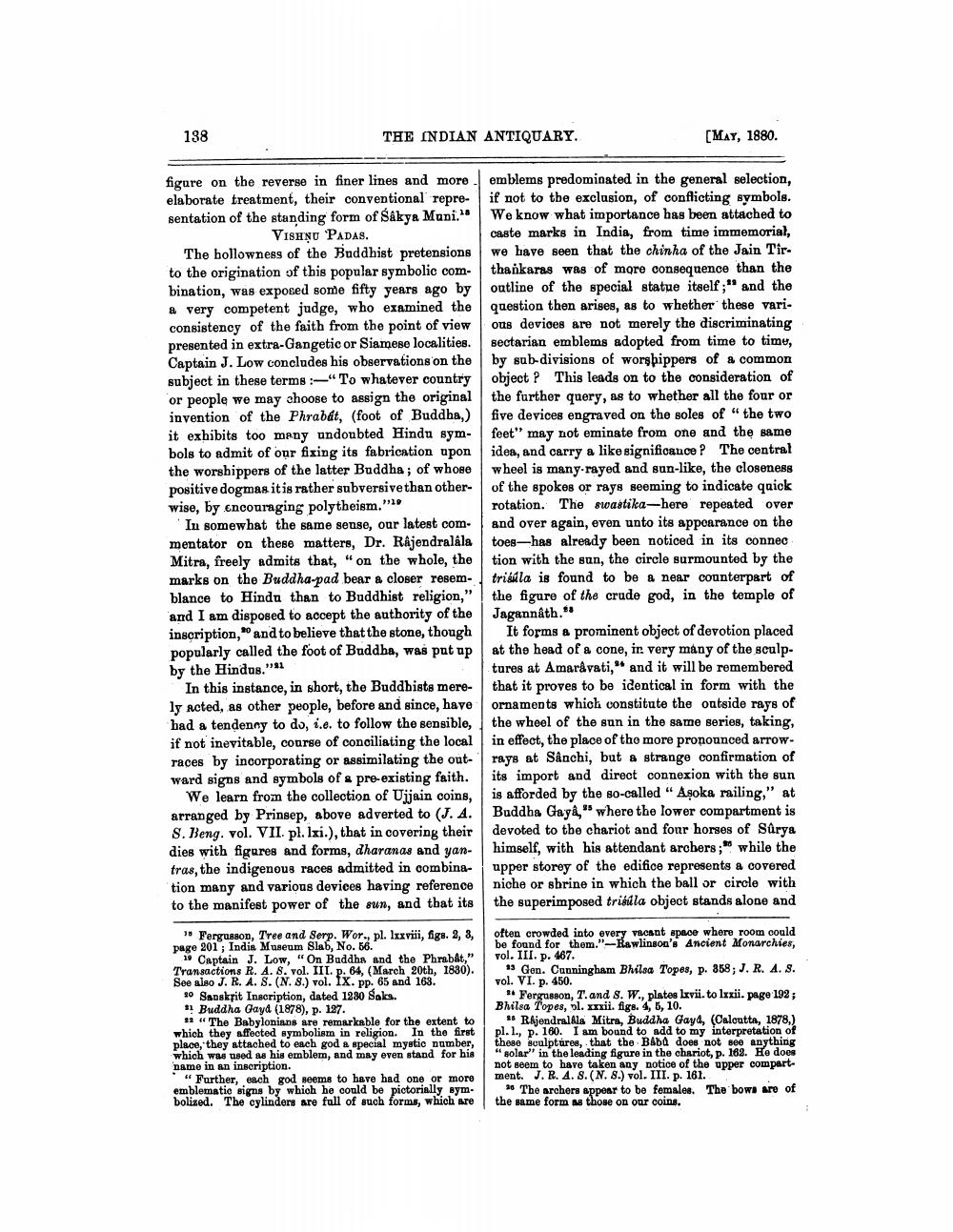________________
138
THE INDIAN ANTIQUARY.
(May, 1880.
figure on the reverse in finer lines and more emblems predominated in the general selection, elaborate treatment, their conventional repre- if not to the exclusion, of conflicting symbols. sentation of the standing form of Sakya Moni. We know what importance has been attached to VISHŅU PADAS.
casto marks in India, from time immemorial, The hollowness of the Buddhist pretensions we have seen that the chinha of the Jain Tirto the origination of this popular symbolic com- thankaras was of more consequence than the bination, was exposed some fifty years ago by outline of the special statue itself;" and the a very competent judge, who examined the question then arises, as to whether these vari. consistency of the faith from the point of view ons devices are not merely the discriminating presented in extra-Gangetic or Siamese localities. sectarian emblems adopted from time to time, Captain J. Low concludes his observations on the by sub-divisions of worshippers of a common subject in these terms :-"To whatever country object? This leads on to the consideration of or people we may choose to assign the original the further query, as to whether all the four or invention of the Phrabát, (foot of Buddha,) five devices engraved on the soles of "the two it exhibits too many undoubted Hindu sym- feet" may not eminate from one and the same bols to admit of our fixing its fabrication upon idea, and carry a like significance? The central the worshippers of the latter Buddha; of whose wheel is many.rayed and sun-like, the closeness positive dogmas it is rather subversive than other- of the spokes or rays seeming to indicate quick wise, by encouraging polytheism."
rotation. The swastika-here repeated over In somewhat the same sense, our latest com and over again, even unto its appearance on the mentator on these matters, Dr. Rajendralála toeg-has already been noticed in its connec Mitra, freely admits that, " on the whole, the tion with the sun, the circle surmounted by the marks on the Buddha-pad bear a closer resem- trilla is found to be a near counterpart of blance to Hindu than to Buddhist religion," the figure of the crude god, in the temple of and I am disposed to accept the authority of the Jagannath." inscription, and to believe that the stone, though It forms a prominent object of devotion placed popularly called the foot of Buddha, was put up at the head of a cone, irvery many of the sculpby the Hindus."
tures at Amaravati," and it will be remembered In this instance, in short, the Buddhists mere that it proves to be identical in form with the ly acted, as other people, before and since, have ornaments which constitute the outside rays of had a tendenny to do, i.e. to follow the sensible, the wheel of the sun in the same series, taking, if not inevitable, course of conciliating the local in effect, the place of the more pronounced arrowraces by incorporating or assimilating the out- rays at Sanchi, but a strange confirmation of ward signs and symbols of s pre-existing faith. its import and direct connexion with the sun
We learn from the collection of Ujjain coins, is afforded by the so-called " Asoka railing," at arranged by Prinsep, above adverted to (J. A. Buddha Gaya," where the lower compartment is S. Beng. vol. VII. pl. lxi.), that in covering their devoted to the chariot and four horses of Surya dies with figures and forms, dharanas and yan- himself, with his attendant arobers; while the tras, the indigenous races admitted in combina- upper storey of the edifice represents a covered tion many and various devices having reference niche or shrine in which the ball or circle with to the manifest power of the sun, and that its the superimposed trišila object stands alone and
" Fergusson, Tree and Serp. Wor., pl. lxxviii, figs. 2, 3, page 201 , India Museum Slab, No. 56.
* Captain J. Low, "On Buddha and the Phrabat," Transactions R. A. 8. vol. III. p. 64, (March 20th, 1880). See also J. R. A. S. (N. 8.) vol. Ix. pp. 65 and 163. 10 Sanskrit Inscription, dated 1280 Saks.
Buddha Gaya (1878), p. 127. 11 The Babylonians are remarkable for the extent to which they affected symbolism in religion. In the first place, they attached to each god a special mystio number, which was used as his emblem, and may even stand for his name in an inscription.
"Further, each god seems to have had one or more emblematic signs by which he could be pictorially symbolized. The cylinders are full of such forms, which are
often crowded into every vacant space where room could be found for them."--Rawlinson's Ancient Monarchies, vol. III. p. 467.
13 Gen. Cunningham Bhilsa Topes, p. 358; J. R. 4. S. vol. VI. p. 450.
". Ferguson, T. and 8. W., plates Livii.to lxxii. page 192; Bhilsa Topes, bl. xxii. figs. 4, 5, 10.
Rjendralala Mitra, Buddha Gaye, (Osloutta, 1878.) pl. l., p. 160. I am bound to add to my interpretation of these soulptures, that the Bibd does not see anything "solar" in the leading figure in the chariot, p. 162. Ho does not seem to have taken any notice of the upper compartment. J. R. 4.8.(N. 8.) vol. III. p. 161.
* The archers appear to be females. The bows are of the same form as those on our coins.




